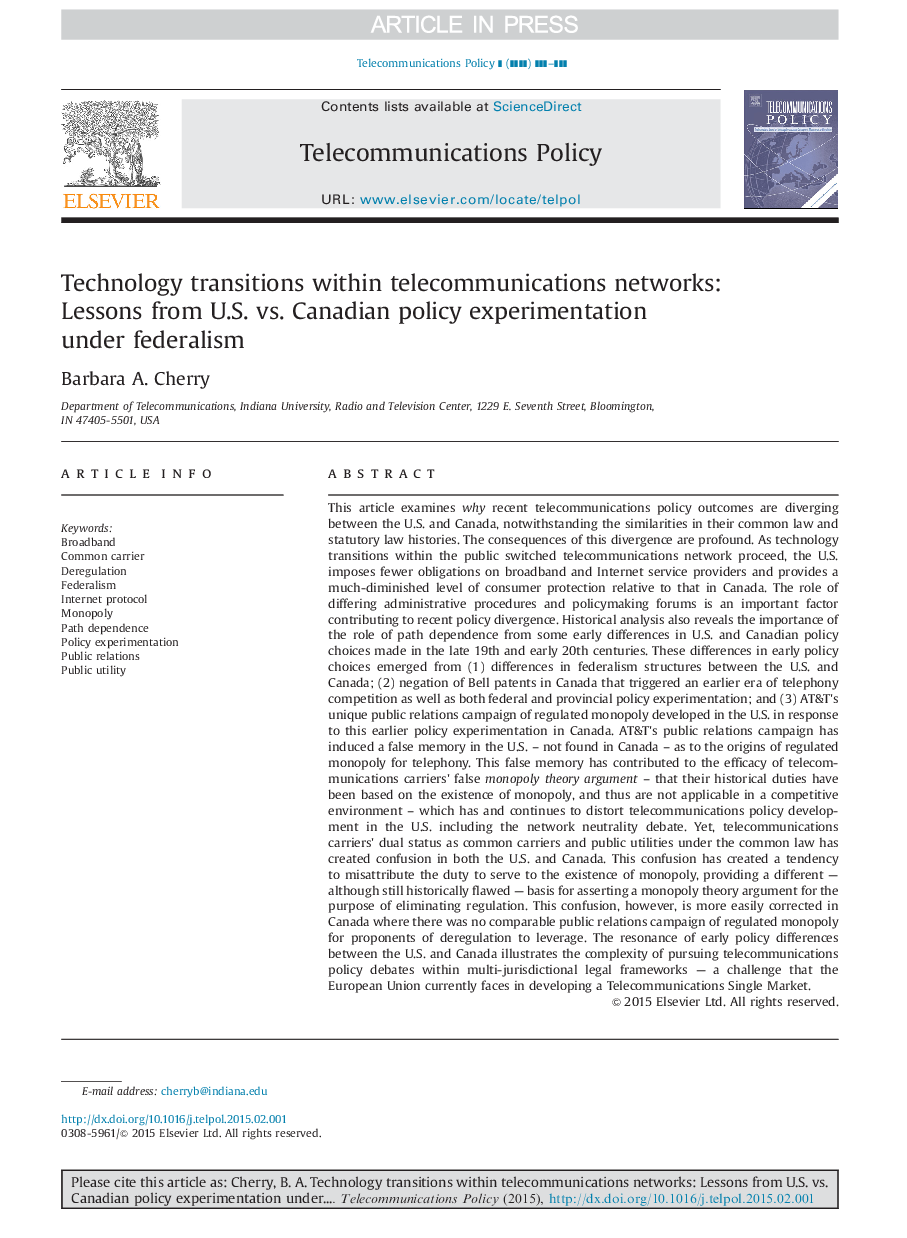| کد مقاله | کد نشریه | سال انتشار | مقاله انگلیسی | نسخه تمام متن |
|---|---|---|---|---|
| 10368241 | 874461 | 2015 | 23 صفحه PDF | دانلود رایگان |
عنوان انگلیسی مقاله ISI
Technology transitions within telecommunications networks: Lessons from U.S. vs. Canadian policy experimentation under federalism
ترجمه فارسی عنوان
انتقال تکنولوژی در شبکه های مخابراتی: درس های آزمایشات سیاست ایالات متحده در مقابل کانادا تحت فدرالیست
دانلود مقاله + سفارش ترجمه
دانلود مقاله ISI انگلیسی
رایگان برای ایرانیان
کلمات کلیدی
پهنای باند، حامل مشترک، مقرراتزدایی، فدرالیسم، پروتکل اینترنت، انحصار، وابستگی مسیر، تجربه آزمایشگاهی روابط عمومی، خدمات عمومی،
موضوعات مرتبط
مهندسی و علوم پایه
مهندسی کامپیوتر
سیستم های اطلاعاتی
چکیده انگلیسی
This article examines why recent telecommunications policy outcomes are diverging between the U.S. and Canada, notwithstanding the similarities in their common law and statutory law histories. The consequences of this divergence are profound. As technology transitions within the public switched telecommunications network proceed, the U.S. imposes fewer obligations on broadband and Internet service providers and provides a much-diminished level of consumer protection relative to that in Canada. The role of differing administrative procedures and policymaking forums is an important factor contributing to recent policy divergence. Historical analysis also reveals the importance of the role of path dependence from some early differences in U.S. and Canadian policy choices made in the late 19th and early 20th centuries. These differences in early policy choices emerged from (1) differences in federalism structures between the U.S. and Canada; (2) negation of Bell patents in Canada that triggered an earlier era of telephony competition as well as both federal and provincial policy experimentation; and (3) AT&T׳s unique public relations campaign of regulated monopoly developed in the U.S. in response to this earlier policy experimentation in Canada. AT&T׳s public relations campaign has induced a false memory in the U.S. - not found in Canada - as to the origins of regulated monopoly for telephony. This false memory has contributed to the efficacy of telecommunications carriers׳ false monopoly theory argument - that their historical duties have been based on the existence of monopoly, and thus are not applicable in a competitive environment - which has and continues to distort telecommunications policy development in the U.S. including the network neutrality debate. Yet, telecommunications carriers׳ dual status as common carriers and public utilities under the common law has created confusion in both the U.S. and Canada. This confusion has created a tendency to misattribute the duty to serve to the existence of monopoly, providing a different - although still historically flawed - basis for asserting a monopoly theory argument for the purpose of eliminating regulation. This confusion, however, is more easily corrected in Canada where there was no comparable public relations campaign of regulated monopoly for proponents of deregulation to leverage. The resonance of early policy differences between the U.S. and Canada illustrates the complexity of pursuing telecommunications policy debates within multi-jurisdictional legal frameworks - a challenge that the European Union currently faces in developing a Telecommunications Single Market.
ناشر
Database: Elsevier - ScienceDirect (ساینس دایرکت)
Journal: Telecommunications Policy - Volume 39, Issue 6, July 2015, Pages 463-485
Journal: Telecommunications Policy - Volume 39, Issue 6, July 2015, Pages 463-485
نویسندگان
Barbara A. Cherry,
